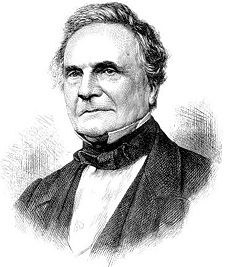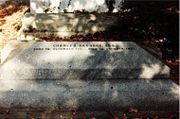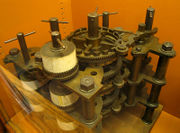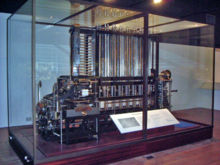Charles Babbage
2008/9 Schools Wikipedia Selection. Related subjects: Computing People
| Charles Babbage | |
 Sketch by Henri Claudet, 1860s
|
|
| Born | 26 December 1791 London, England |
|---|---|
| Died | 18 October 1871 (aged 79) Marylebone, London, England |
| Nationality | United Kingdom |
| Fields | Mathematics, analytic philosophy, computer science |
| Institutions | Trinity College, Cambridge |
Charles Babbage, FRS ( 26 December 1791 London, England – 18 October 1871 Marylebone, London, England) was an English mathematician, philosopher, inventor and mechanical engineer who originated the concept of a programmable computer. Parts of his uncompleted mechanisms are on display in the London Science Museum. In 1991 a perfectly functioning difference engine was constructed from Babbage's original plans. Built to tolerances achievable in the 19th century, the success of the finished engine indicated that Babbage's machine would have worked. Nine years later, the Science Museum completed the printer Babbage had designed for the difference engine, an astonishingly complex device for the 19th century. Babbage is credited with inventing the first mechanical computer that eventually led to more complex designs.
Biography
Birth
The birthplace of Charles Babbage is disputed, but he was most likely born in 44 Crosby Row, Walworth Road, London, England. A blue plaque on the junction of Larcom Street and Walworth Road commemorates the event.
Babbage's date of birth was given in his obituary in The Times as 26 December 1792. However, after the obituary appeared, a nephew wrote to say that Charles Babbage actually was born one year earlier, in 1791. The parish register of St. Mary's Newington, London, shows that Babbage was baptized on 6 January 1792, supporting a birth year of 1791.
Charles's father, Benjamin Babbage, was a banking partner of the Praeds who owned the Bitton Estate in Teignmouth. His mother was Betsy Plumleigh Teape. In 1808, the Babbage family moved into the old Rowdens house in East Teignmouth, and Benjamin Babbage became a warden of the nearby St. Michael’s Church.
Education
His father's money allowed Charles to receive instruction from several schools and tutors during the course of his elementary education. Around the age of eight he was sent to a country school in Alphington near Exeter to recover from a life-threatening fever. His parents ordered that his "brain was not to be taxed too much" and Babbage felt that "this great idleness may have led to some of my childish reasonings." For a short time he attended King Edward VI Grammar School in Totnes, South Devon, but his health forced him back to private tutors for a time. He then joined a 30-student Holmwood academy, in Baker Street, Enfield, Middlesex under Reverend Stephen Freeman. The academy had a well-stocked library that prompted Babbage's love of mathematics. He studied with two more private tutors after leaving the academy. Of the first, a clergyman near Cambridge, Babbage said, "I fear I did not derive from it all the advantages that I might have done." The second was an Oxford tutor from whom Babbage learned enough of the Classics to be accepted to Cambridge.
Babbage arrived at Trinity College, Cambridge in October 1810. He had read extensively in Leibniz, Joseph Louis Lagrange, Thomas Simpson, and Lacroix and was seriously disappointed in the mathematical instruction available at Cambridge. In response, he, John Herschel, George Peacock, and several other friends formed the Analytical Society in 1812. Babbage, Herschel and Peacock were also close friends with future judge and patron of science Edward Ryan. Ultimately, Babbage and Ryan married sisters.
In 1812 Babbage transferred to Peterhouse, Cambridge. He was the top mathematician at Peterhouse, but failed to graduate with honours. He instead received an honorary degree without examination in 1814.
Marriage, family, death
On July 25, 1814, Babbage married Georgiana Whitmore at St. Michael's Church in Teignmouth, Devon. The couple lived at Dudmaston Hall, Shropshire (where Babbage engineered the central heating system), before moving to 5 Devonshire Street, Portland Place, London.
Charles and Georgiana had eight children, but only three — Benjamin Herschel, Georgiana Whitmore, and Henry Prevost — survived to adulthood. Georgiana died in Worcester on September 1, 1827. Charles' father, wife, and at least two sons all died in 1827. These deaths caused Babbage to go into a mental breakdown which delayed the construction of his machines.
His youngest son, Henry Prevost Babbage (1824-1918), went on to create six working difference engines based on his father's designs, one of which was sent to Howard H. Aiken, pioneer of the Harvard Mark I. Henry Prevost's 1910 Analytical Engine Mill, previously on display at Dudmaston Hall, is now on display at the Science Museum.
Charles Babbage died at age 79 on October 18, 1871, and was buried in London's Kensal Green Cemetery. According to Horsley, Babbage died "of renal inadequacy, secondary to cystitis." In 1983 the autopsy report for Charles Babbage was discovered and later published by one of his descendants. A copy of the original is also available. Babbage's brain is preserved at the Science Museum in London.
Design of computers
Babbage sought a method by which mathematical tables could be calculated mechanically, removing the high rate of human error. Three different factors seem to have influenced him: a dislike of untidiness; his experience working on logarithmic tables; and existing work on calculating machines carried out by Wilhelm Schickard, Blaise Pascal, and Gottfried Leibniz. He first discussed the principles of a calculating engine in a letter to Sir Humphry Davy in 1822.
Babbage's engines were among the first mechanical computers, although they were not actually completed, largely because of funding problems and personality issues. He directed the building of some steam-powered machines that achieved some success, suggesting that calculations could be mechanized. Although Babbage's machines were mechanical and unwieldy, their basic architecture was very similar to a modern computer. The data and program memory were separated, operation was instruction based, the control unit could make conditional jumps and the machine had a separate I/O unit.
Difference engine
In Babbage’s time numerical tables were calculated by humans who were called ‘computers,’ meaning "one who computes," much as a conductor is "one who conducts." At Cambridge he saw the high error rate of this human-driven process and started his life’s work of trying to calculate the tables mechanically. He began in 1822 with what he called the difference engine, made to compute values of polynomial functions. Unlike similar efforts of the time, Babbage's difference engine was created to calculate a series of values automatically. By using the method of finite differences, it was possible to avoid the need for multiplication and division.
The first difference engine was composed of around 25,000 parts, weighed fifteen tons (13,600 kg), and stood 8 ft (2.4 m) high. Although he received ample funding for the project, it was never completed. He later designed an improved version, "Difference Engine No. 2", which was not constructed until 1989-1991, using Babbage's plans and 19th-century manufacturing tolerances. It performed its first calculation at the London Science Museum returning results to 31 digits, far more than the average modern pocket calculator.
Replicas
Two full-scale modern replicas of the Difference Engine have been constructed by the London Science Museum. One is owned by the museum and the other, owned by technology millionaire Nathan Myhrvold, went on exhibit at the Computer History Museum in Mountain View, California on 10 May 2008. It will remain there until April 2009, when it will be placed in Myhrvold's personal collection.
Analytical engine
Soon after the attempt at making the difference engine crumbled, Babbage started designing a different, more complex machine called the Analytical Engine. The engine is not a single physical machine but a succession of designs that he tinkered with until his death in 1871. The main difference between the two engines is that the Analytical Engine could be programmed using punch cards, an idea unheard of in his time. He realized that programs could be put on similar cards so the person had only to create the program initially, and then put the cards in the machine and let it run. The analytical engine was also proposed to use loops of Jacquard's punched cards to control a mechanical calculator, which could formulate results based on the results of preceding computations. This machine was also intended to employ several features subsequently used in modern computers, including sequential control, branching, and looping, and would have been the first mechanical device to be Turing-complete.
Ada Lovelace, an impressive mathematician and one of the few people who fully understood Babbage's ideas, created a program for the Analytical Engine. Had the Analytical Engine ever actually been built, her program would have been able to calculate a sequence of Bernoulli numbers. Based on this work, Lovelace is now widely credited with being the first computer programmer. In 1979, a contemporary programming language was named Ada in her honour. Shortly afterward, in 1981, a satirical article by Tony Karp in the magazine Datamation described the Babbage programming language as the "language of the future".
Modern adaptations
While the abacus and mechanical calculator have been replaced by electronic calculators using microchips, the recent advances in MEMS and nanotechnology have led to recent high-tech experiments in mechanical computation. The benefits suggested include operation in high radiation or high temperature environments.
These modern versions of mechanical computation were highlighted in the magazine The Economist in its special "end of the millennium" black cover issue in an article entitled Babbage's Last Laugh . The article highlighted work done at University of California Berkeley by Ezekiel Kruglick. In this Doctoral Dissertationthe researcher reports mechanical logic cells and architectures sufficient to implement the Babbage Analytical engine (see above) or any general logic circuit. Carry-shift digital adders and various logic elements are detailed as well as modern analysis on required performance for microscopic mechanical logic.
Other accomplishments
In 1824, Babbage won the Gold Medal of the Royal Astronomical Society "for his invention of an engine for calculating mathematical and astronomical tables."
From 1828 to 1839 Babbage was Lucasian Professor of Mathematics at Cambridge. He contributed largely to several scientific periodicals, and was instrumental in founding the Astronomical Society in 1820 and the Statistical Society in 1834. However, he dreamt of designing mechanical calculating machines.
“... I was sitting in the rooms of the Analytical Society, at Cambridge, my head leaning forward on the table in a kind of dreamy mood, with a table of logarithms lying open before me. Another member, coming into the room, and seeing me half asleep, called out, "Well, Babbage, what are you dreaming about?" to which I replied "I am thinking that all these tables" (pointing to the logarithms) "might be calculated by machinery. "
In 1837, responding to the Bridgewater Treatises, of which there were eight, he published his Ninth Bridgewater Treatise, "On the Power, Wisdom and Goodness of God, as manifested in the Creation", putting forward the thesis that God had the omnipotence and foresight to create as a divine legislator, making laws (or programs) which then produced species at the appropriate times, rather than continually interfering with ad hoc miracles each time a new species was required. The book is a work of natural theology, and incorporates extracts from correspondence he had been having with John Herschel on the subject.
Babbage also achieved notable results in cryptography. He broke Vigenère's autokey cipher as well as the much weaker cipher that is called Vigenère cipher today. The autokey cipher was generally called "the undecipherable cipher", though owing to popular confusion, many thought that the weaker polyalphabetic cipher was the "undecipherable" one. Babbage's discovery was used to aid English military campaigns, and was not published until several years later; as a result credit for the development was instead given to Friedrich Kasiski, a Prussian infantry officer, who made the same discovery some years after Babbage.
In 1838, Babbage invented the pilot (also called a cow-catcher), the metal frame attached to the front of locomotives that clears the tracks of obstacles. He also constructed a dynamometer car and performed several studies on Isambard Kingdom Brunel's Great Western Railway in about 1838. Babbage's eldest son, Benjamin Herschel Babbage, worked as an engineer for Brunel on the railways before emigrating to Australia in the 1850s
Babbage also invented an ophthalmoscope, but although he gave it to a physician for testing it was forgotten, and the device only came into use after being independently invented by Hermann von Helmholtz.
Babbage twice stood for Parliament as a candidate for the borough of Finsbury. In 1832 he came in third among five candidates, but in 1834 he finished last among four.
In On the Economy of Machine and Manufacture, Babbage described what is now called the Babbage principle, which describes certain advantages with division of labour. Babbage noted that highly skilled - and thus generally highly paid - workers spend parts of their job performing tasks that are 'below' their skill level. If the labour process can be divided among several workers, it is possible to assign only high-skill tasks to high-skill and -cost workers and leave other working tasks to less-skilled and paid workers, thereby cutting labour costs. This principle was criticised by Karl Marx who argued that it caused labour segregation and contributed to alienation. The Babbage principle is an inherent assumption in Frederick Winslow Taylor's scientific management.
Eccentricities
- Babbage once counted all the broken panes of glass of a factory, publishing in 1857 a "Table of the Relative Frequency of the Causes of Breakage of Plate Glass Windows": Of 464 broken panes, 14 were caused by "drunken men, women or boys".
- Babbages's distaste for commoners ("the Mob") included writing "Observations of Street Nuisances" in 1864, as well as tallying up 165 "nuisances" over a period of 80 days; he especially hated street music, and in particular the music of organ grinders, against whom he railed in various venues. The following quotation is typical:
-
- It is difficult to estimate the misery inflicted upon thousands of persons, and the absolute pecuniary penalty imposed upon multitudes of intellectual workers by the loss of their time, destroyed by organ-grinders and other similar nuisances.
- Babbage once contacted the poet Alfred Tennyson in response to his poem "The Vision of Sin". Babbage wrote, "In your otherwise beautiful poem, one verse reads,
-
- Every moment dies a man,
- Every moment one is born.
- Every moment dies a man,
- ... If this were true, the population of the world would be at a standstill. In truth, the rate of birth is slightly in excess of that of death. I would suggest [that the next version of your poem should read]:
-
- Every moment dies a man,
- Every moment 1 1/16 is born.
- Every moment dies a man,
- Strictly speaking, the actual figure is so long I cannot get it into a line, but I believe the figure 1 1/16 will be sufficiently accurate for poetry."
Quotations
| “ | On two occasions I have been asked, – "Pray, Mr. Babbage, if you put into the machine wrong figures, will the right answers come out?" In one case a member of the Upper, and in the other a member of the Lower, House put this question. I am not able rightly to apprehend the kind of confusion of ideas that could provoke such a question. | ” |
Commemoration
Babbage has been commemorated by a number of references, as shown on this list. In particular, the Babbage crater, on the Moon, and the Charles Babbage Institute, an information technology archive and research centre, were named after him. The large Babbage lecture theatre at Cambridge University, used for undergraduate science lectures, commemorates his time at the university.
Publications
- Babbage, Charles (1826). A Comparative View of the Various Institutions for the Assurance of Lives. London: J. Mawman.
- Babbage, Charles (1830). Reflections on the Decline of Science in England, and on Some of Its Causes. London: B. Fellowes.
- Babbage, Charles (1835). On the Economy of Machinery and Manufactures, 4, London: Charles Knight.
- Babbage, Charles (1837). The Ninth Bridgewater Treatise, a Fragment. London: John Murray.
- Babbage, Charles (1841). Table of the Logarithms of the Natural Numbers from 1 to 108000. London: William Clowes and Sons.
- Babbage, Charles (1851). The Exposition of 1851. London: John Murray.
- Babbage, Charles (1864). Passages from the Life of a Philosopher. London: Longman.


